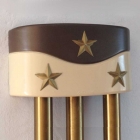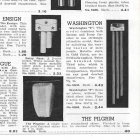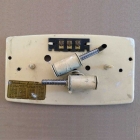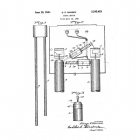Rittenhouse Washington “3” Tubular Doorbell
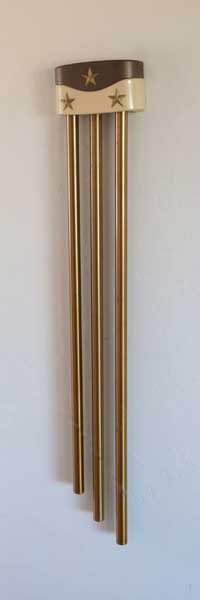
This well preserved pre-war long bell door chime resides in a Seattle door chime niche. This chime can be reliably dated by the latest patent number on the label: 2245453 issued in June of 1941. The patent application was made in April of 1940 and granted in June of 1941. This chime can be found in a hardware catalog from 1940 as model 6G59. The Washington “2” is also listed without the decorative third “silent” tube as model 6G60. This chime was not shown in post-war Rittenhouse sales literature. As the Rittenhouse Factory was quickly turned over to war production shortly after the U.S. entry into the war in December of 1941, this example was manufactured between 1940 and early 1942.
Patent 2245453 deals with the unique arrangement of the solenoid strikers. This arrangement is, at best, a marginal improvement and was not available after the war although it did find its way into several Rittenhouse designs and those of their Cleartone sub-brand.
If you care to follow along with the actual patent claim, here it is:
In structures of this kind employing two chime tubes, it has been usual, through the instrumentality of different controlling circuits and switches or push buttons, to provide for striking only one chime tube to give a single note signal and striking both chime tubes successively to give a double note signal, and in the construction shown, both chime tubes 4 and 5 are successively sounded by strikers 6 and 1 carried on a plunger 8 forming part of the electrically controlled unit or solenoid 9. The striker 7 engages and strikes the upper end of the chime tube 5 when the solenoid circuit is closed, and the striker 6 engages and strikes the upper end of the chime tube 4 upon the return movement of the plunger 8 under influence of the spring Hl when the solenoid-controlling circuit is opened, as usual in this class of device. The chime tube 5 is supported by a cord H engaging the bracket 3 and connected to a cylindrical plug, not shown, in the upper end of the chime tube, the latter being always struck on its cylindrical striking surface adjacent to the upper end thereof.
The other chime tube 4 is adapted to be struck either after the chime tube 5, to give a double note signal, or independently to give a single note signal, and in order to accomplish this purpose, there is preferably provided a solid plug or portion l 2 fixedly secured in the upper end of the tube 4 by a drive fit Or otherwise. The body portion of the plug l2, which is preferably of metal, is of cylindrical form to fit closely within the end of the tube 4 opposite its cylindrical striking surface that is engaged by the striker 6, and the plug or solid portion extends beyond the upper end of the tube 4 afiording a conical or tapered striking surface 13 adjacent to the end of the tube and adjacent to the cylindrical striking surface before mentioned that is engaged by the striker 5. The chime tube 4 is supported on the bracket 2 by means of a cord M that is suitably secured to the metal plug Within the end of the tube.
The conical striking surface l3 is engaged by a striker l5 carried by a plunger i5 forming part of the solenoid ll and arranged at an angle to the aforementioned plunger 8 and its solenoid 9, and positioned perpendicularly to the conical striking surface i3. locating the solenoid I? in close relationship to the solenoid 9 so that the strikers 6 and 55 may engage striking surfaces that are adjacently positioned and in close proximity to each other. This enables a compact positioning of the separate electrically operated striker mechanisms on the base I, and requires a minimum sized housing for enclosing the electric mechanism and the upper ends of the chime tubes. l8 designates a stop for limiting return movement of the plunger it under the influence of spring l9.
| Manufacturer | A.E. Rittenhouse Co., Inc. | |
| Location of Manufacturer | Honeyoye Falls, New York, USA | |
| Date of Manufacture | Between 1940 and 1942 | |
| Materials | Painted Steel Case with brass details. Brass tubular bells. | |
| Dimensions | 7 1/4 inches wide, 41 inches tall, 2 3/4 inches deep | |
| Details | Mechanically restored for original Seattle home. Patina preserved. |
